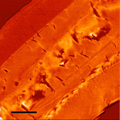Washington, D.C.— Surprising new research shows that, contrary to conventional belief, remains of chitin-protein complex—structural materials containing protein and polysaccharide—are present in abundance in fossils of arthropods from the Paleozoic era. Previously the oldest molecular signature of chitin-protein complex was discovered in 25 million year old Cenozoic fossils and remnants of structural protein have also been discovered in 80 million-year-old Mesozoic fossils. Carnegie’s George Cody and an international team of scientists discovered relicts of protein-chitin complex in fossils of arthropods from the Paleozoic era. Their findings, published online by Geology, could have major implications for our understanding of the organic fossil record.
Among other common features, arthropods have exoskeletons, or cuticles. The outer portions of these cuticles are made up of a composite of chitin fibers, which are embedded in a matrix of protein. It is well known that chitin and structural protein are easily degraded by microorganisms and it has long been believed that chitin and structural proteins would not be present in fossils of moderate age, let alone in fossils dating back to the early Paleozoic.

High resolution X-ray Absorption Image mapping organic nitrogen abundance (brighter) in an ultra-thin section of modern scorpion cuticle. Scale bar = 5 µm. Image credit: Carnegie Institution for Science
Cody and his team studied fossil remains of a 310-million-year-old scorpion cuticle from northern Illinois and a 417-million-year-old eurypterid—an extinct scorpion-like arthropod, possibly related to horseshoe crabs—from Ontario, Canada. Using sophisticated analytical instrument at the Advanced Light Source facility, the research team measured the absorption spectra of low-energy X-rays by carbon, nitrogen, and oxygen in the fossils. These measurements were taken at a resolution on the order of 25 nanometers. The researchers showed that the majority of carbon, nitrogen and oxygen found in these fossils from the Paleozoic era were derived from a protein-chitin complex. Not surprisingly, the protein-chitin material was somewhat degraded, either by chemical processes or partial bacterial degradation.
Cody speculates that the vestigial protein-chitin complex may play a critical role in organic fossil preservation by providing a substrate protected from total degradation by a coating waxy substances that protect the arthropods from desiccation.
*Source: Carnegie Institution for Science
